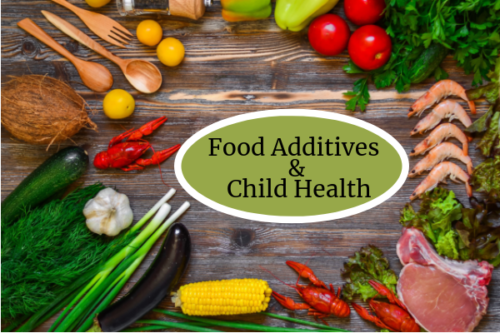Last month the American Academy of Pediatrics (AAP) published a policy statement titled “Food Additives and Child Health”. Many doctors and parents alike have had food additives on our radar for the last decade or so, but this is the first time the AAP has directly addressed the polarizing topic.
 What are food additives?
What are food additives?
The AAP defines food additives as “colorings, flavorings, and chemicals deliberately added to food during processing (direct food additives) as well as substances in food contact materials, including adhesives, dyes, coatings, paper, paperboard, plastic, and other polymers, which may contaminate food as part of packaging or manufacturing equipment (indirect food additives)”¹.
Why is this important?
The most recent legislation on food additives was completed in 1958. At this point the “Generally Recognized as Safe” category was created and numerous chemicals were grandfathered in. Given our now superior testing methods there is still no process to re-test chemicals that have previously been approved, or to have unbiased evaluation of new chemicals. Many of these chemicals have been linked to endocrine disruption, increased risk of obesity and thyroid dysfunction. With children being at an increased susceptibility due to their small size and underdeveloped detoxifications processes within their body, this is a huge concern for all of our children and their development.
What can you do now?
- Eat as much of your diet as possible in whole food forms. Think fresh or frozen fruits, vegetables and minimally processed proteins. Be sure to wash your produce before you eat it. You will never find these items in a box on a shelf, so search the perimeter of your grocery store!
- Avoid processed meats, especially those containing nitrates/nitrites. These are often found in hot dogs, bacon and lunch meats.
- Avoid microwaving any foods in plastic containers and try to switch food storage to glass or stainless steel containers where possible.
- Learn some important recycle codes: 3 (phthalates), 6 (styrene) and 7 (bisphenols). Containers with these codes on the bottom should be avoided unless they are labeled as “greenware” or “biobased”.
What can you do in the future?
I urge you to keep these concerns in mind as you vote and offer your support to these issues in the coming years. The AAP calls for updating the outdated system for evaluating food additives, requesting retesting of substances previously grandfathered into the “Generally Recognized as Safe (GRAS)” category, and urging the FDA to require labeling of all food additives that have not been proven to be safe with greater transparency needed for the consumer.
This policy statement is a pivotal step forward for the AAP by advocating for our smallest and most vulnerable patients. I am hopeful for the future as we learn more about how best to keep ourselves and our children safe and healthy.

Special thanks to Dr. Tori Smith (DO, FAAP) from Mercy Pediatric Clinic for sharing her expertise with us today. We are so grateful for the amazing staff at the Mercy Clinic, who work so hard to ensure that our children’s health and wellness are at the forefront of everything we do. If you or anyone you know are looking for a pediatrician, check out their clinic at https://www.mercyiowacity.org/pediatric-clinic.
{sources}










